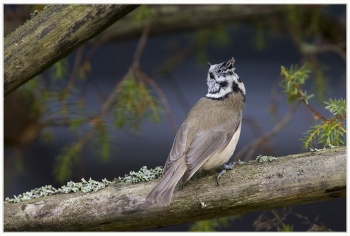- Lophophanes cristatus
Identification
Length 11.5-12 cm, weight 10-16 g
Overall dark brown above, pale brown to whitish below, with head marked black and white. It is an easy tit to recognise, for besides its erectile crest, the tip of which is often recurved, its black gorget and collar are distinctive. Eye red to brown; bill and legs dark grey.
Similar species
Effectively none within its natural range; in very poor light and with the crest flattened, it could possibly be mistaken for a Blue Tit. A striking example of convergent evolution can be found in Bridled Titmouse (from Mexico), which differs only in the less black freckling on the face.
Distribution
Throughout most of Europe except for Italy south of the Po Valley, and in the extreme west of Asia in the Ural Mountains. In southeast Europe (the Balkan Peninsula) it is restricted to higher altitudes, above 1000 m altitude. In Great Britain, it is restricted to the ancient pinewoods and older plantations in Scotland, primarily the Spey Valley and Great Glen, an area 80 × 80 km, and seldom strays far from its haunts; surprisingly, it is absent from suitable habitat on Deeside and the Rannoch and Loch Maree pinewoods. A very few vagrant Crested Tits have been seen in England. It is resident, and most birds do not migrate; as well as being absent as a breeding bird from Ireland, England and Wales, its unwillingness to cross even short stretches of sea leave it absent from islands in the Baltic Sea area (Saaremaa, Hiiumaa, Gotland, Öland, Bornholm, Sjælland) and the Mediterranean.
Taxonomy
Subspecies
Six or seven subspecies are accepted[1][2]:
- L. c. scoticus:
- L. c. abadiei:
- Western France (Bretagne)
- L. c. weigoldi:
- L. c. cristatus:
- L. c. baschkirikus:
- Southern Urals
- L. c. mitratus:
- Central and western Europe
- L. c. bureschi (included in L. c. mitratus by some authors[1])
- Balkans
The subspecies differ in plumage tone, with greyer-brown birds in the east of the range and more rufous-brown birds in the west. The mainland European subspecies intergrade extensively where they meet.
Habitat
It is a widespread and common resident breeder in coniferous forests throughout central and northern Europe, with a strong preference for Scots Pine Pinus sylvestris, and to a lesser extent Norway Spruce Picea abies. Further southwest, it occurs in mixed woodland in France and the Iberian peninsula; in the Pyrenees often in Beech Fagus sylvatica forests, and in Spain and Portugal commonly in Cork Oak Quercus suber woods.
Behaviour
Breeding
It makes a nest in a hole in rotting stumps. This bird often feeds low down in trees, but although not shy, it is not always easily approached. It will join winter tit flocks with other species.
Diet
Like other tits, it feeds on insects, including caterpillars, and seeds; Scots Pine seeds are important the late winter.
Vocalisation
The commonest call is a very distinctive soft purring trill; also has a variety of other typical tit-like calls, some resembling Coal Tit.
References
- Clements, JF. 2011. The Clements Checklist of Birds of the World. 6th ed., with updates to August 2011. Ithaca: Cornell Univ. Press. ISBN 978-0801445019. Spreadsheet available at http://www.birds.cornell.edu/clementschecklist/downloadable-clements-checklist
- Del Hoyo, J, A Elliott, and D Christie, eds. 2007. Handbook of the Birds of the World. Volume 12: Picathartes to Tits and Chickadees. Barcelona: Lynx Edicions. ISBN 978-8496553422
- Avibase
Recommended Citation
- BirdForum Opus contributors. (2024) Crested Tit. In: BirdForum, the forum for wild birds and birding. Retrieved 4 May 2024 from https://www.birdforum.net/opus/Crested_Tit
External Links






